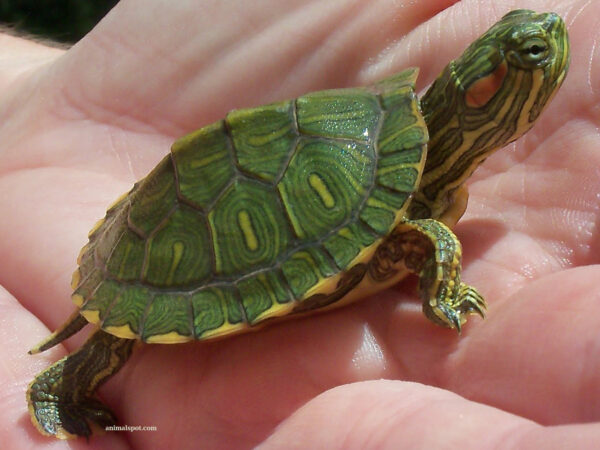
Red-eared Slider
(Trachemys scripta elegans)
Species at a Glance
The Red-eared Slider is a hardy freshwater turtle that is popular as an aquarium pet in the United States. It gets its name from the broad red stripes present behind each eye. Its popularity in the pet trade has helped account for its numerous introductions worldwide, and it is now designated as one of the “100 World’s Worst Invaders” by the Global Invasive Species Database.
Species Description
The most distinguishing characteristic of the Red-eared Slider is the unique, broad, reddish-orange patch found behind each eye. The shell is yellowish to dark green with black or off-white stripes. The skin is olive to brown in color with yellow stripes or spots. Adults can reach up to 30 cm (12 in) in length, and female sliders are typically larger than males. This species of turtle may be confused with the invasive Yellow-bellied Slider, which has a yellow patch behind each eye instead of red; or the native, Red-bellied Turtle, which has a distinctive orange to reddish color on the underside of the shell.
Native & Introduced Ranges
The native range includes Midwestern states within the Gulf Coast basin and the Mississippi Valley extending as far east as West Virginia. Since the 1970s, massive numbers of young turtles have been generated on turtle farms to be sold in the pet trade. In Pennsylvania, the first recorded occurrence of the Red-eared Slider was in 1996 in Lehigh County. This turtle can now be found in many counties across Pennsylvania.
Biology & Spread
Red-eared Sliders are the most commonly exported turtle species and are sold as hatchlings, measuring over four inches in length. Adult sliders can reach lengths of up to 30 cm (12 in), and unsuspecting owners are rarely prepared to continue maintaining them in captivity at this size, which often leads to intentional release into the environment. This action is detrimental to native ecosystems and is illegal in Pennsylvania. Red-eared Sliders are also long-lived, reaching ages of up to 40 years in captivity.
Habitat
The Red-eared Slider is a hardy turtle that can flourish in many kinds of habitats. It is frequently seen basking on rocks, logs, vegetation masses, and banks. It prefers quiet or slow-moving waters such as ponds and wetlands and can tolerate brackish and fairly polluted waters. It is also able to hibernate over the winter to survive the cold-water temperatures.
Impacts
Threat to Biodiversity
Red-eared Sliders are aggressive omnivores, feeding on fish, plants, insects, amphibians, and other aquatic organisms and their eggs. This puts them in direct competition with many native species of turtles for food, basking areas, and nesting sites. Particularly at risk is the Pennsylvania threatened Red-bellied Turtle, which has virtually identical foraging and nesting habitats, and food requirements.
Threat to Human Health
Red-eared Sliders pose a risk to human health because their ability to survive and reproduce in polluted waters makes them prone to contracting and spreading disease. In particular, sliders have been associated with carrying harmful bacteria such as Salmonella. In 1975, the Food and Drug Administration placed a ban on the sale of Red-eared Sliders under four inches to prevent Salmonella outbreaks in children, who are more likely to handle the small turtles or put them in their mouths.
Prevention & Control
Small hatchlings are readily available by mail order or from the Internet and are still considered a popular aquarium pet. The best way to control the spread of the Red-eared Slider is to prevent their introduction.
- Never release unwanted aquarium pets and plants into the wild. Instead look for alternatives, such as contacting a retailer for proper handling advice or for possible returns.
- Give or trade with another aquarist, pond owner, or water gardener, or donate to a local aquarium society, school, or aquatic business. Another option is to seek out an aquarium pet adoption organization or a local aquarium pet surrender event.
- Disposal of live organisms should be considered a last resort; however, if this is an option be sure to contact a veterinarian or pet retailer for guidance about humane disposal of animals.
References:
- Urban, C. A. and Morgan, R.T. 2006. Distribution of the Invasive
- Red- Eared Slider Turtle (Trachemys scripta elegans) in the Lower Delaware River Basin.
- Somma., L.A, Foster, A., and Fuller, P. 2009. Trachemys scripta elegans. USGS Nonindigenous Aquatic Species Database, Gainesvile, FL.



